This post is about my experience baking bread in a cloche on Saturday. This loaf can be made completely in one day and baked in a ceramic or stoneware cloche or a Dutch oven.
The Saturday White Bread from Ken Forkish’s book Flour, Water, Salt & Yeast was the bread of the month for the Artisan Bread Bakers.
The idea behind Saturday Bread is that you can make it from start-to-finish in one day. A lot of the breads in the book are made using the long, slow fermentation-in the-refrigerator method, but Mr. Forkish included this one for homebakers who want to start a bread in the morning and serve it for dinner that same evening. I like that! Most homebakers, including me, could easily fit this bread in their schedule, especially on a Saturday or Sunday.
Although I like the idea of a Saturday bread, I didn’t think an all-white bread, without an overnight fermentation in the refrigerator, would have enough flavor so I included 10% whole wheat flour to give it a more rustic appeal.
As I’ve mentioned before, one of the things I really like about this book is that all of the formulas can easily be scaled up or down and adapted to suit your needs or appetite. I only wanted one loaf so I scaled the formula down to make one loaf instead of two.
I also adapted the method a bit. I’m still dealing with tennis elbow so I have to be careful about picking up things that put a strain on my wrist or elbow. It’s a bit tricky sometimes to find a pot I can lift and twist without dropping it, especially if the pot is hot.
With these limitations in mind, I decided to bake the loaf in my La Cloche instead of a Dutch oven, bread pot, or my combo baker because: 1) it’s easier to transfer the risen dough from the proofing basket to the La Cloche; 2) the La Cloche doesn’t have to be preheated; and 3) it simulates a brick oven so the bread comes out crispy on the outside and rises really well, and 4) I just love the bell-shaped dome.
10% Whole Wheat Saturday Bread
Adapted from: Flour Water Salt Yeast: The Fundamentals of Artisan Bread and Pizza by Ken Forkish
Makes: One loaf (about 1 1/2 pounds)
If you want to see what this bread looks like baked in a pot, visit Karen’s Kitchen Stories. Karen made this bread a few weeks ago and it looks fabulous.
This dough can be used for bread, pizza or focaccia. I think it would make great focaccia. Next time, I’ll make the full amount so I can have some left over to use for pizza or focaccia.
Ingredients:
- 400 grams unbleached all-purpose flour
- 100 grams whole wheat flour
- 360 grams warm water (90 degrees F. to 95 degrees F.)
- 11 grams fine sea salt
- 2 grams instant dried yeast
Directions:
1)
Mix the flour and water
Combine the all-purpose and whole wheat flours and water and mix by hand using a wooden spoon or a Danish dough whisk until thoroughly incorporated.
2) Autolyse (rest the dough)
Cover the dough and let it rest for 20 to 30 minutes.
3) Mix in the Salt and Yeast
After the dough has rested, sprinkle the salt and yeast over the top of the dough. Mix by hand until the salt and yeast are fully incorporated into the dough. Using wet hands for this part makes it really easy. Continue to wet your hands as necessary throughout the mixing process.
4) Fold and Turn the Dough
Instead of kneading the dough, Mr. Forkish uses the pincer method. I love the name of his method, but I’m more proficient with the fold-and-turn method from Chad Robertson’s Tartine Bread so that’s the method I used for this dough.
With the fold-and-turn method, you basically do a series of turns and folds in the bowl to develop the gluten structure.
Refer to my Tartine Bread post for a photo tutorial on performing the fold-and-turn method.
5) Bulk Fermentation
Cover the dough and let it rise. Do two folds during the first 1 1/2 after mixing. The first fold should be done about 10 minutes after mixing and the 2nd fold should be done within the next hour. When you see the dough spread out in the bowl, you’ll know it’s ready to be folded It’s actually pretty cool.
You can fold the dough a little later if necessary, but be sure to let the dough rest during the last hour of rising. The dough should be triple it’s size in volume after about 5 hours after mixing. I started this process at 11 am and the dough was ready at 4 pm.
6) Shape the Dough
I only made one loaf so I didn’t need to divide the dough. I just shaped it into a ball and placed it in a well-floured banneton basket. A mixture of all-purpose and rice flour works really well for this purpose.
7) Proof the Dough
Lightly flour the top of the dough. Cover the basket with plastic wrap or a kitchen towel. Let the loaf proof for an hour to an hour and a half. My kitchen was warm so it only took an hour.
Use the finger dent test to see when the loaf is fully proofed and ready to be baked. Watch a demonstration by Ken Forkish of the finger-proof test.
8) Prepare the Oven for Baking
45 minutes to an hour before baking the loaf, preheat the oven to 500 degrees F. If you are using a La Cloche, you don’t need to preheat it. Just remove the middle rack from the oven so you can place the La Cloche on the bottom rack.
9) Score the Loaf
Sprinkle the bottom of the La Cloche with cornmeal. When the loaf is fully proofed, gently invert it onto the bottom of the La Cloche.
Score the loaf in the pattern of your choice using a lame or serrated knife.
10) Bake the Loaf
Place the La Cloche on the bottom rack of the oven and cover it with the lid. Turn the oven down to 450 degrees F. Bake the loaf for 20 minutes with the lid on.
Remove the lid and bake for an additional 20 minutes or until the loaf is a medium dark brown. Just be careful not to burn the bottom of the loaf.
Remove the loaf from the La Cloche to a wire rack to cool. You’ll also want to place the La Cloche lid and bottom on a towel to cool down. This will keep them from cracking due to extreme temperature change.
11) Slice and Enjoy
After the bread has cooled completely, slice and enjoy it. The bottom of my loaf was burned in a couple of places, but I just sliced that part off with a knife.
We enjoyed it as a toasted cheese sandwich on Sunday. Love the crunchy texture with the melted cheese!
Happy Baking!
Cathy
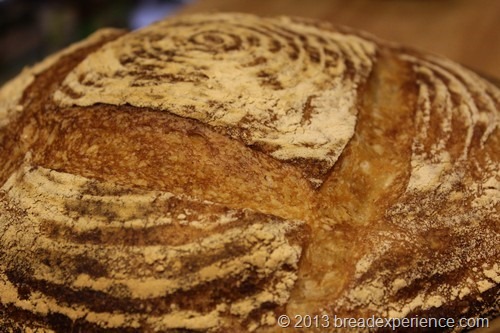
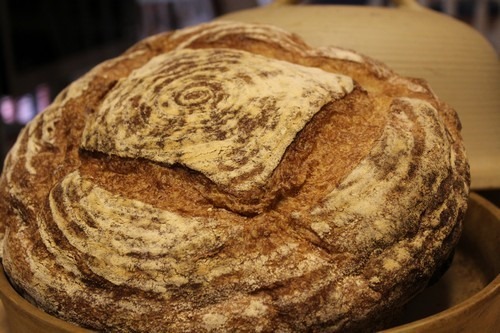
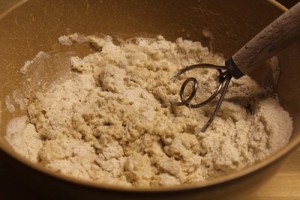
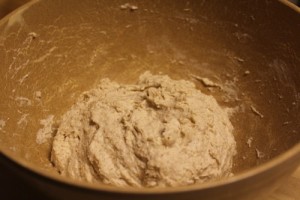
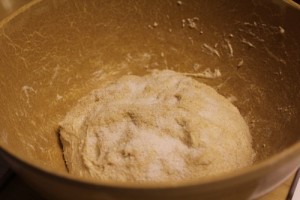
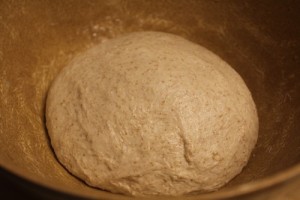
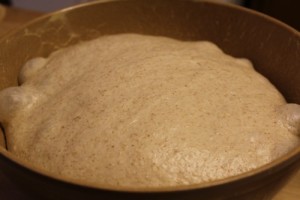
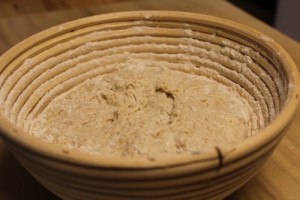
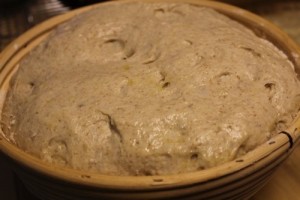
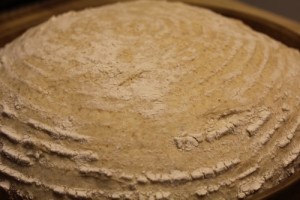
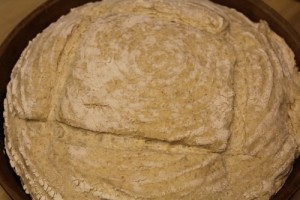
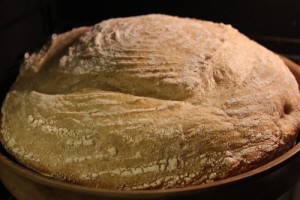
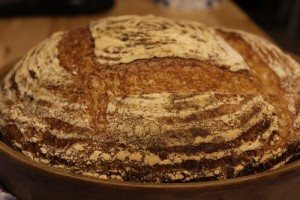
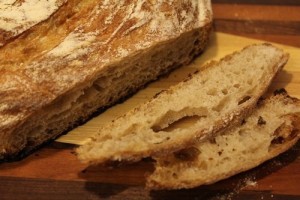
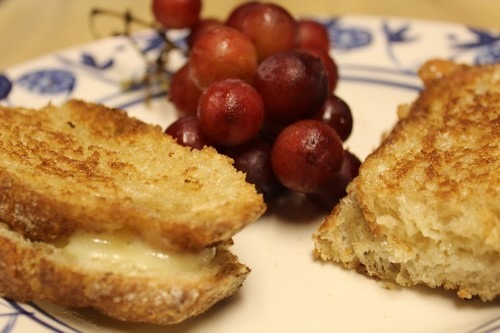
Karen Kerr says
I want that cheese sandwich! Beautiful post Cathy!
Anonymous says
we have a Baker here in Astascadero Ca that makes Artisan Bread and the outside crust of the loaf is very hard but the inside is so tender…it is the best..will the loaf that is shown above come out the same ??? Thank You for your timely answer…Paul
Cathy W. says
Hello, this bread is made from a lean dough which means it doesn’t have any tenderizers in it – only flour, water, salt and yeast. The crust (outside) will be crusty and the crumb (inside) will not be hard; however, it won’t be like a soft sandwich loaf.
Jen says
What would the cooking time be if not cooking in La Cloche? And would it need to be covered. I can now see why these dishes are handy. They are wet loaves!
Cathy says
Hi Jen,
The baking time would be the same, but check it as you would any loaf. In order to get the benefits of the steam environment that you get from a cloche or Dutch oven, then yes, it needs to be covered. If you don’t have a cloche or Dutch oven, you can bake it on a preheated baking stone, using a steam pan, and cover the loaf with a big stainless bowl during baking.
Happy Baking!
Cathy